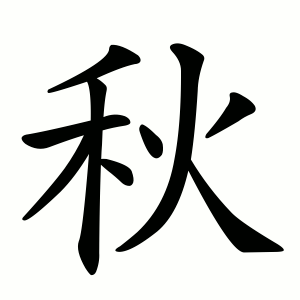秋
- autumn;
- fall;
Etymology
The oldest forms (oracle bone script) depicted a cricket or grasshopper, since these insects chirp in autumn or infest crops during the harvest season.
Over time, the original pictographic form was abandoned. The character was reinterpreted as a compound of:
禾 (grain, rice plant) – semantic element, representing crops;
火 (fire) – semantic element, originally related to slash-and-burn agriculture (burning fields after harvest).
There is also a stage in the character’s evolution where the insect form was misinterpreted: the head was reanalyzed as 禾, the tail as 火, and the body as 龜 (gwi, turtle). Later, the 龜 component was dropped, leaving the current 禾 + 火 form.
Thus, 秋 came to symbolize “autumn,” the harvest season, as well as burning fields after harvest.
Semantic range:
- autumn, fall – the season after summer, associated with harvest.
- harvest time – crops and reaping in autumn.
- by extension: seasonal or cyclical change.
Usage in Korean
Today it universally means autumn, harvest season, and appears in many seasonal, agricultural, and cultural compounds.
입추 (立秋) – the start of autumn (solar term)
추분 (秋分) – autumn equinox
추석 (秋夕) – Korean Harvest Festival (Chuseok)
추수 (秋收) – autumn harvest
추수감사절 (秋收感謝節) – Thanksgiving
추상 (秋霜) – autumn frost (figurative: severity)
춘추 (春秋) – spring and autumn; also title of Confucius’s chronicle Spring and Autumn Annals
Words that derived from 秋
Alternative forms
It has several variant forms, including 秌, 𤇫, 𥝛, 𥡄, 𥡌. (Note: in some digital environments, these forms may not render correctly.)
- 竹木火 (HDF)
- ⿰ 禾 火
